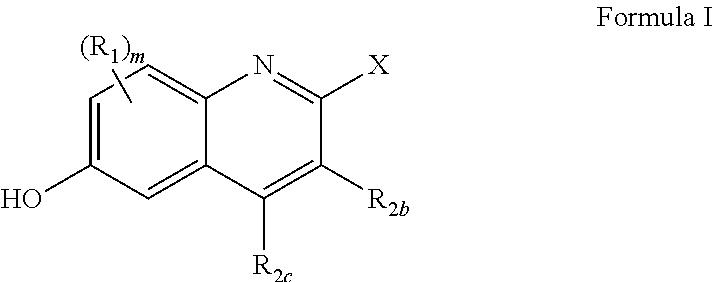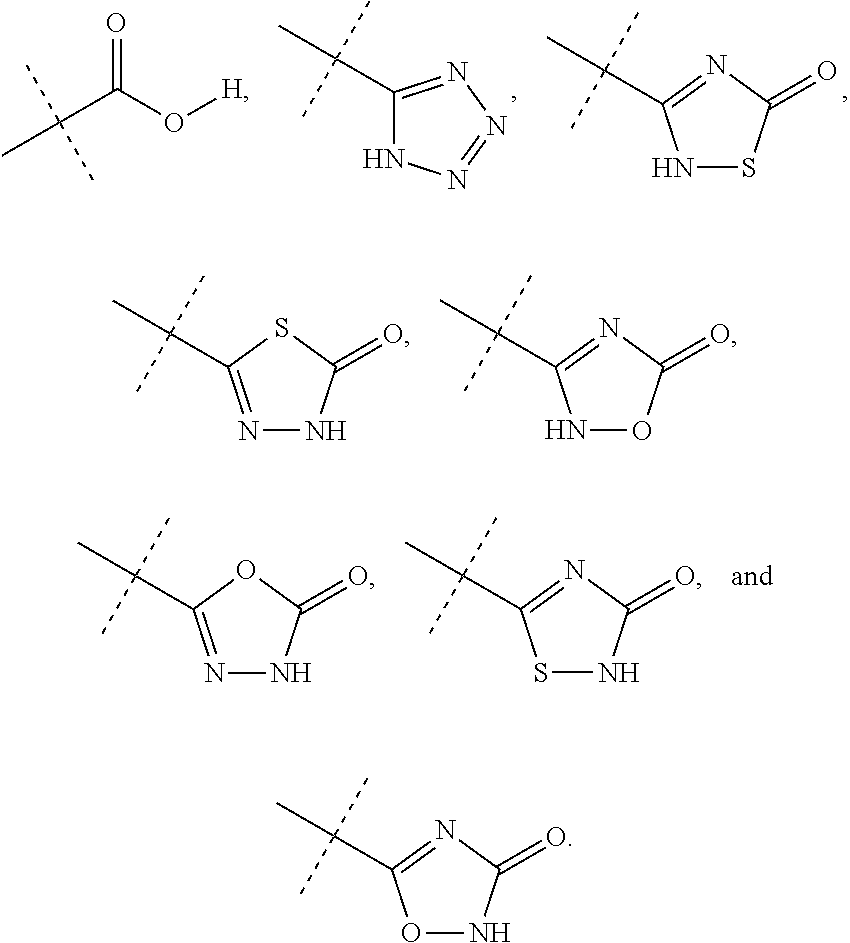Substituted quinoline compounds as S-nitrosoglutathione reductase inhibitors
- Summary
- Abstract
- Description
- Claims
- Application Information
AI Technical Summary
Benefits of technology
Problems solved by technology
Method used
Image
Examples
example 1
Compound 1: 4-(6-hydroxy-3-methylquinolin-2-yl)benzoic acid
[0225]
[0226]Followed Scheme 1
Step 1: Synthesis of Methyl 4-(6-methoxy-3-methylquinolin-2-yl)benzoate
[0227]To a mixture of 2-chloro-6-methoxy-3-methylquinoline (100 mg, 0.482 mmol), 4-(methoxycarbonyl)phenylboronic acid (184 mg, 1.02 mmol), TEA (0.35 mL, 2.41 mmol), and PdCl2(dppf) (35 mg, 0.048 mmol) was added 2 mL of DMF under argon. The mixture was then stirred for 2.5 h at 120° C. in a microwave reactor. The crude mixture was then diluted with water (25 mL) and extracted with EtOAc (25 mL×2). The organics were washed with brine (50 mL), dried over sodium sulfate, and concentrated to yield 250 mg of crude material. The crude was purified via column chromatography with a gradient of 5% EtOAc in hexanes to 80% EtOAc in hexanes to yield 37 mg (25% yield) of methyl 4-(6-methoxy-3-methylquinolin-2-yl)benzoate.
Step 2: Synthesis of 4-(6-hydroxy-3-methylquinolin-2-yl)benzoic acid
[0228]Methyl 4-(6-methoxy-3-methylquinolin-2-yl)benz...
example 2
Compound 2: 2-(4-(1H-tetrazol-5-yl)phenyl)-3-methylquinolin-6-ol
[0229]
[0230]Followed Scheme 2: A conditions
Step 1: Synthesis of 2-(4-(1H-tetrazol-5-yl)phenyl)-6-methoxy-3-methylquinoline
[0231]To a mixture of 2-chloro-6-methoxy-3-methylquinoline (100 mg, 0.482 mmol), 4-(1H-tetrazol-5-yl)phenylboronic acid (91.2 mg, 0.482 mmol), K2CO3 (199 mg, 1.45 mmol), and PdCl2(dppf) (17.6 mg, 0.024 mmol) was added 7 mL of DEGME and 3 mL of H2O under argon. The mixture was stirred at 150° C. in a microwave reactor for 1.5 hours. The crude mixture was diluted with 1N NaOH (10 mL) and slowly acidified to a pH of 4.0 using conc. HCl. The solids were filtered to yield 128 mg (84% yield) of desired product.
Step 2: Synthesis of (2-(4-(1H-tetrazol-5-yl)phenyl)-3-methylquinolin-6-ol)
[0232]2-(4-(1H-tetrazol-5-yl)phenyl)-6-methoxy-3-methylquinoline (128 mg, 0.40 mmol) was dissolved in 5 mL of NMP and Na2S (47 mg, 0.60 mmol) was added to it. The mixture was then stirred for 4 hours at 140° C. in a microwave ...
example 3
Compound 3: 4-(6-hydroxyquinolin-2-yl)benzoic acid
[0233]
[0234]Followed Scheme 2, A conditions: Starting materials: 2-chloro-6-methoxyquinoline (Intermediate 1) (100 mg, 0.52 mmol) and (4-(methoxycarbonyl)phenyl) boronic acid. 1H NMR (DMSO-d6, 400 MHz): δ 13.06-12.90 (bs, 1H), 10.14 (s, 1H), 8.36-8.33 (d, 2H), 8.30-8.27 (d, 1H), 8.11-8.06 (m, 3H), 7.97-7.94 (d, 1H), 7.38-7.34 (dd, 1H), 7.20 (s, 1H). MS (ESI): m / z 266.08 [M+H]+.
PUM
 Login to View More
Login to View More Abstract
Description
Claims
Application Information
 Login to View More
Login to View More - R&D Engineer
- R&D Manager
- IP Professional
- Industry Leading Data Capabilities
- Powerful AI technology
- Patent DNA Extraction
Browse by: Latest US Patents, China's latest patents, Technical Efficacy Thesaurus, Application Domain, Technology Topic, Popular Technical Reports.
© 2024 PatSnap. All rights reserved.Legal|Privacy policy|Modern Slavery Act Transparency Statement|Sitemap|About US| Contact US: help@patsnap.com










